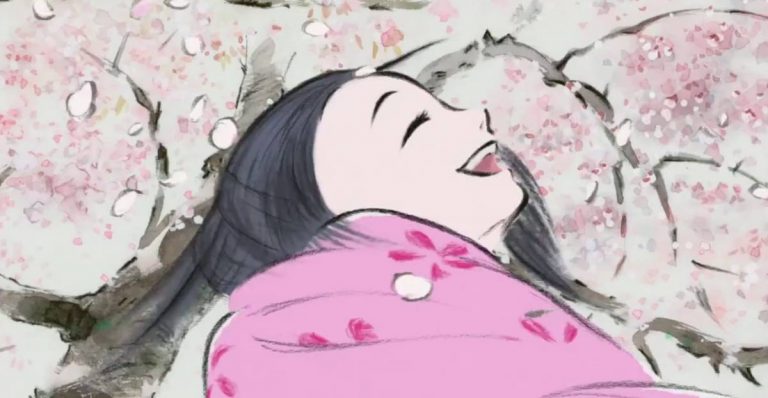I was fortunate enough to catch Princess Kaguya on the big screen, and I would encourage you all to do the same even if animation isn’t your thing. People often refer to Studio Ghibli as the Japanese sister studio to Disney but even although I can see the similarities, I’m a firm believer that Ghibli is more like Disney’s edgier distant relative.
The Tale of Princess Kaguya has all of the elements you would expect from the studio. Beautifully poignant storytelling merges perfectly with delicate Japanese brushstroke style animation resulting in what is arguably the most visually impressive film the studio has released. But there’s a lot more to this story than meets the eye (literally).
The story is based on the Japanese folk story ‘The Tale of the Bamboo Cutter’ and follows the fate of a Bamboo cutter who stumbles upon a baby Princess growing inside a bamboo stalk. Upon bringing her home he and his wife raise her as their own child in the idyllic Japanese countryside. The girl is clearly special in the way she experiences extraordinary growth spurts (Just like the bamboo she was found in) and even at a young age she possesses unrivalled beauty. The bamboo cutter believes she is a gift from heaven and realising she is made for better things than a simple life in the country he decides to move the family to the city where she can become a real Princess. Through rigorous training and extreme physical changes she is transformed into a real Princess but it is clear that she is repressed and unhappy in her new role and wishes to return to her simple and carefree life in the forest. Princess Kaguya outsmarts all of her ghastly royal suitors by making them complete impossible tasks much to the annoyance of her deluded father.
The Princess becomes increasingly introverted and distant from her family as the film develops and chooses instead to spend her time in solitude gazing up at the moon. She reveals to her mother that in a moment of fury she wished for the people of the moon to come and take her home. Her parents are distraught at the thought of losing their daughter and it is at this point where the story becomes particularly poignant. Princess Kaguya realises she would have been happy if she had stayed in the country and lived a simple life, this sentiment is expressed through a wonderful fantasy sequence, and the fantasy element continues until the movies end when the people of the moon return to take Princess Kaguya to her real home. This brings the story to its bittersweet end with the Princess returning to the moon forgetting all about her time on earth, separated forever from the people that raised her. The haunting memories of a half-forgotten earth reflected in the tears in her eyes for all eternity.
Princess Kaguya is a very moving, beautiful story and I would expect no less from the creators that brought us Spirited Away and Takahata’s earlier masterpiece Grave of the Fireflies. It touches on a range of serious issues including: the repression of women, loss and regret, human memory and the idyllic representation of country life. The film will stay with you long after the credits roll and like all Ghibli movies it is extremely thought provoking and keeps its audience captivated for the films entirety. It is definitely worth a trip to the cinema if only to experience the impressive score and distinctive animation but I believe it will provide you with much more than simply an aesthetically pleasing way to spend a couple of hours. I caught the English dubbed version, and the voice cast put in very impressive performances, although I am confident the film will probably be appreciated best in its native Japanese if possible.
Some of the coverage you find on Cultured Vultures contains affiliate links, which provide us with small commissions based on purchases made from visiting our site. We cover gaming news, movie reviews, wrestling and much more.



